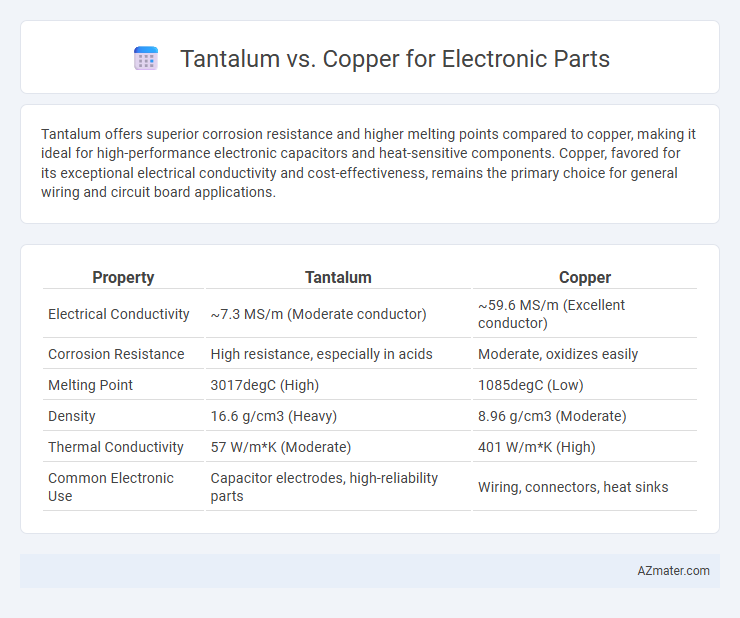Tantalum offers superior corrosion resistance and higher melting points compared to copper, making it ideal for high-performance electronic capacitors and heat-sensitive components. Copper, favored for its exceptional electrical conductivity and cost-effectiveness, remains the primary choice for general wiring and circuit board applications.
Table of Comparison
| Property | Tantalum | Copper |
|---|---|---|
| Electrical Conductivity | ~7.3 MS/m (Moderate conductor) | ~59.6 MS/m (Excellent conductor) |
| Corrosion Resistance | High resistance, especially in acids | Moderate, oxidizes easily |
| Melting Point | 3017degC (High) | 1085degC (Low) |
| Density | 16.6 g/cm3 (Heavy) | 8.96 g/cm3 (Moderate) |
| Thermal Conductivity | 57 W/m*K (Moderate) | 401 W/m*K (High) |
| Common Electronic Use | Capacitor electrodes, high-reliability parts | Wiring, connectors, heat sinks |
Introduction to Tantalum and Copper in Electronics
Tantalum is a rare, corrosion-resistant metal widely used in electronic components such as capacitors due to its high capacitance per volume and stable performance at various temperatures. Copper, renowned for its excellent electrical conductivity and thermal properties, serves as a primary material in circuit boards, wiring, and connectors. Both metals play crucial roles in electronics, with tantalum favored for miniaturized, high-reliability components and copper essential for efficient electrical transmission and heat dissipation.
Material Properties: Tantalum vs Copper
Tantalum offers superior corrosion resistance and a high melting point of 2996degC, making it ideal for capacitors and electronic components exposed to harsh environments. Copper provides excellent electrical conductivity at 5.96x10^7 S/m and thermal conductivity around 400 W/m*K, crucial for efficient heat dissipation and signal transmission in electronic interconnects. The choice between tantalum and copper depends on balancing conductivity needs with durability and resistance to oxidation in electronic applications.
Electrical Conductivity Comparison
Copper exhibits significantly higher electrical conductivity, approximately 5.96 x 10^7 S/m, compared to tantalum's conductivity of around 7.4 x 10^6 S/m, making copper the preferred choice for efficient current flow in electronic components. Tantalum's lower conductivity is offset by its superior corrosion resistance and stability in high-temperature environments, often utilized in capacitors and specialized circuits. For applications demanding maximal electrical conductivity, copper remains the optimal material due to its excellent electron mobility and minimal resistive losses.
Thermal Conductivity and Heat Management
Tantalum offers lower thermal conductivity, approximately 57 W/m*K, compared to copper's superior 401 W/m*K, making copper more efficient for heat dissipation in electronic components. Copper's high thermal conductivity ensures faster heat transfer, crucial for maintaining stability and performance in high-power devices. Tantalum's heat management benefits stem from its corrosion resistance and stability at high temperatures, but copper remains the preferred choice where rapid heat conduction and thermal management are critical.
Corrosion Resistance and Longevity
Tantalum offers superior corrosion resistance compared to copper, making it ideal for electronic components exposed to harsh environments and moisture. Its natural oxide film provides excellent protection against chemical degradation, significantly enhancing the longevity of capacitors and other parts. Copper, while highly conductive, is more susceptible to oxidation and corrosion, which can reduce the lifespan of electronic components in corrosive conditions.
Cost Analysis: Tantalum vs Copper
Tantalum offers superior capacitance and stability for electronic parts but carries a significantly higher material and processing cost compared to copper. Copper's affordability and excellent electrical conductivity make it the preferred choice for cost-sensitive applications despite lower performance in specific capacitor roles. Evaluating total cost of ownership requires balancing tantalum's premium price against copper's efficiency and widespread availability in electronic manufacturing.
Use Cases in Electronic Components
Tantalum is widely used in electronic components like capacitors and high-reliability circuits due to its exceptional capacitance per volume and resistance to corrosion. Copper, favored for its superior electrical conductivity and thermal performance, is commonly employed in printed circuit boards (PCBs), wiring, and connectors. Choosing between tantalum and copper depends on specific use cases: tantalum excels in miniaturized, high-capacitance applications, while copper is indispensable for efficient power distribution and signal integrity in electronic assemblies.
Environmental and Supply Chain Considerations
Tantalum offers superior corrosion resistance and thermal stability for electronic parts but is often linked to significant environmental and ethical concerns due to conflict mineral sourcing, leading to complex supply chain scrutiny. Copper, while less costly and abundant, faces challenges related to mining pollution and high energy consumption during extraction and refining processes. Sustainable sourcing initiatives and recycling efforts are critical in mitigating the environmental footprint and ensuring supply chain resilience for both materials in electronics manufacturing.
Reliability and Performance in Harsh Conditions
Tantalum capacitors exhibit superior reliability and stable performance in harsh environments due to their high capacitance-to-volume ratio, excellent temperature tolerance, and resistance to corrosion compared to copper-based components. Copper's excellent electrical conductivity supports high current applications but may suffer from oxidation and mechanical stress in extreme temperatures or humid conditions, affecting long-term durability. In critical harsh conditions, tantalum's robustness and stability make it the preferred choice for maintaining consistent electronic performance and minimizing failure rates.
Future Trends and Innovations in Electronic Materials
Tantalum is gaining prominence in electronic components due to its superior capacitance and thermal stability compared to copper, especially in miniaturized and high-frequency applications. Emerging innovations in nanostructured tantalum capacitors reveal enhanced durability and energy density, positioning it as a key material for next-generation smartphones and IoT devices. Copper remains essential for conductivity and cost-efficiency, but advancements in tantalum-based materials are driving future trends toward more compact, efficient, and reliable electronic parts.

Infographic: Tantalum vs Copper for Electronic part
 azmater.com
azmater.com